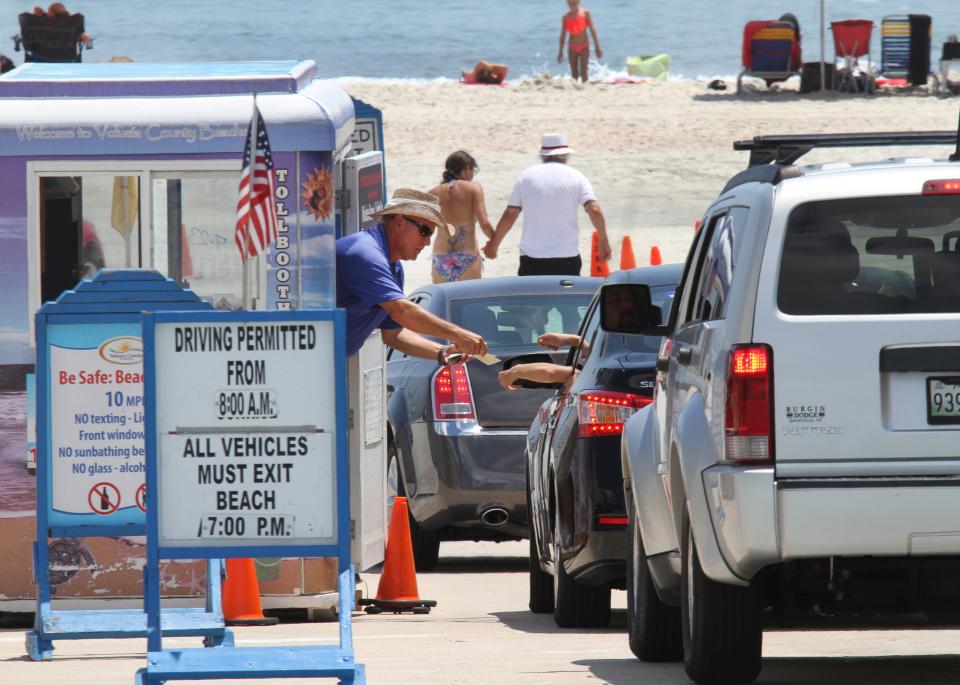Beach driving in Volusia County: What to know when you cruise the coast
Volusia County is known for its beach driving, but there are rules in place to help people have a smooth experience and avoid getting towed or hurting someone.
"For years, beachgoers have enjoyed a leisurely drive on the wide, hard-packed sands," according to the county government. "Please be a responsible beach driver by driving only in designated areas and observing the speed limit. The driving areas are designated by signs and wooden posts. Please watch for pedestrians, sunbathers and wildlife. Parking is allowed east, or seaward, of the posts."
Here are some key things to know about beach driving in Volusia County.
Pay attention to signs
Follow signs to stay inside of designated beach driving zones and lanes. The county marks off conservation areas.
"We have those (conservation zone) poles on the beach, and people need to make sure they park .... with all four wheels on the east side of those," Interim Beach Safety Director Tammy Malphurs said.
Headlights on, windows down
County laws require people to drive with "headlights on and at least one front window completely open." The speed limit of 10 mph is strictly enforced, according to the Volusia Beaches app.
Loud music ― anything that can be heard from over 50 feet away ― is against the law.
District 4 Councilman and Vice Chair Troy Kent, of Ormond Beach, offered some additional tips for beach drivers. Watch out for children running into the traffic lanes. Check the tides. Make sure your vehicle can handle beach driving.
"And enjoy the heck out of our beautiful Volusia County beaches," he said.
When can I drive on the beach?
Beach driving hours are 8 a.m. to 7 p.m. (or sundown, if that comes first) from May 1-Oct. 31 during turtle nesting season. Beaches are open between sunrise and sunset from Nov. 1 to April 30.
Beach access can change sometimes, such as with high tides and bad weather.
Is it four-wheel drive only?
The Volusia Beaches app shows what vehicle access ramps are four-wheel drive only, which are closed for tides and other information.
People still get stuck in the sand frequently. Malphurs said people should pay attention to signs and talk to toll-takers to see if they have any advice about problem areas.
What does it cost to drive on the beach?

The cost is $20 a day per vehicle. Annual passes are $25 for Volusia County residents and $100 for others. People with a handicap-registered vehicle can drive for free on the beach. The county also offers passes for inlet parks and combo passes for inlet parks and the regular beaches.
People can find beach pass information at volusiabeachpass.com or by calling 866-398-6352.
Changes could be on the way for beach driving fees. The County Council is expected to vote soon on a proposal to give residents free access but charge visitors $30 a day and $150 for an annual pass. The changes would be in effect on Oct. 1.
Beach driving changes ahead? Volusia residents would drive on the beach free under new proposal, visitors would pay more
No Carolina Squat allowed on the beach
The County Council adopted a law in 2023 that bans leaned-back vehicles (vehicles with an elevated front) from the beach.
Can I bring alcohol to the beach?
No. Alcohol isn't allowed.
People can grill on the beach, but it's not OK to throw charcoal in a beach trash can or leave it in the sand.
For a list of rules check out the county's Beach Code section of the County Code at volusia.org/government/county-ordinances.stml.
This article originally appeared on The Daytona Beach News-Journal: What to know about driving on beach in Volusia County

